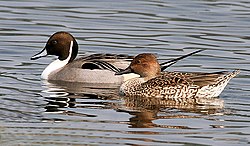This is a fairly large duck, with a long pointed tail that gives rise to the species' English and scientific names. The Northern Pintail's many names describe the male's two long black tail feathers, which in flight look like a single pin or twig (thus, the nickname sprig). These feathers are very distinctive, accounting for a quarter of the total length of the drake when in full plumage.[2] Fast and graceful fliers, pintails are equipped with long wings, small heads, and long necks that seem built for streamlined aerodynamics. Both sexes have blue gray bills and gray legs and feet. The drake is more striking, having a thin white stripe running from the back of its chocolate-colored head down its neck to its mostly white undercarriage. The drake also has attractive gray, brown, and black patterning on its back and sides. The hen's plumage is more subtle and subdued, with drab brown feathers similar to those of other female dabblers. Hens make a coarse quack and the drakes a flute-like whistle.[2]
The Northern Pintail is a bird of open wetlands which nests on the ground, often some distance from water. It feeds by dabbling for plant food and adds small invertebrates to its diet during the nesting season. It is highly gregarious when not breeding, forming large mixed flocks with other species of duck.
This duck's population is affected by predators, parasites and avian diseases. Human activities, such as agriculture, hunting and fishing, have also had a significant impact on numbers. Nevertheless, this species' huge range and large population mean that it is not threatened globally.

No comments:
Post a Comment